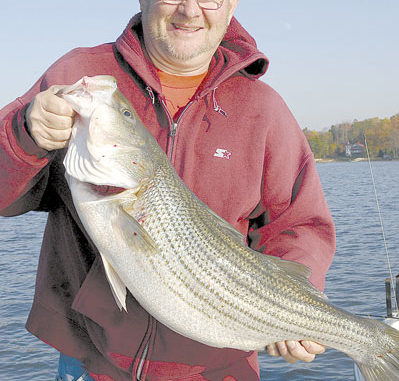
High Rock Lake is making a play to become the Yadkin system’s best striper lake.
For years, Jerry Hill lived and fished — and guided fishermen for striped bass — on Badin Lake.He moved up Rt. 8 from one end of Davidson County to the other two years ago, settling on High Rock Lake, and now he’s doing most of his fishing on High Rock — but not because of proximity.
He admits there’s no way he’ll catch as many striped bass, aka rockfish, at High Rock as he normally would at Badin, but he’s decided that the prospects for catching trophy striped bass are so much better at High Rock than Badin, that he’s staying home — literally — more often, and especially in the late fall.
“I started coming back up here some, and I like it so much because you catch bigger fish,” said Hill. “I caught a 19-pound fish at High Rock about 25 years ago, and my biggest has been a 24-pounder.
“Most of the time when you fish High Rock, you won’t catch the numbers of fish you catch at Badin, but you catch bigger fish. You don’t go and catch 3- to 10-pound fish. You catch a lot of fish 10 pounds and up, no, 12 pounds and up. You catch a lot in the teens and some up to 20.”
Hill, who has caught more than 50 fish on half-day trips on Badin in past years, is satisfied at catching four or five, maybe a half-dozen per trip at High Rock. The fishing is tougher, but the rewards are much greater, er, heavier.
In the late fall and through the winter, catching stripers is a matter of finding baitfish in huge masses and pulling bucktails and Sassy Shad through and around him.
Hill is a troller; he’s trolled homemade bucktails for 25 years, first on planers and downriggers, now on downriggers and leadcore line. He can cover an amazing amount of water in a half-day’s time, and that’s usually long enough to find a decent concentration of fish and get a few of them in the boat.
“In November and early December, I’ll be fishing in the main river anywhere between High Rock Dam and Crane Creek. I won’t fish above Crane, because it’s too shallow. Last year, they were between Second Creek and Crane Creek,” said Hill (336-247-1265). “They’ll leave the river and move into the creeks sometime toward the last of December, when the water temperature gets down in the low 50s.
“They’ll go in as far back as the bait goes. The bait is so thick, all they’ve got to do is open their mouths and they’ll get a stomach full. I’ve trolled through shad so thick that I’ll hook them on my bucktails and Sassy Shad.”
Hill looks for big wads of baitfish on his depthfinder, but the best fishfinders he has are probably the seagulls that arrive on High Rock when the weather gets cold. Inevitably, the birds will stay close to the bait, somehow able to see the big schools of shad from above the water. The stripers will also be around, albeit well below the surface.
“I troll all around the bait I mark; if you find bait, the fish will be around them. If you can find seagulls, the fish will be close by,” he said.
“Most of the time, you’ll catch ’em 10 to 12 feet deep, but you may have to go down to 14 or 15 feet. You shouldn’t have to go much deeper than that.”
Stripers will be shadowing mostly threadfin shad, which don’t take well to cold weather and often die — providing gamefish with an easy meal. Threadfins are the smaller of the two species of shad that inhabit most North Carolina reservoirs — are the other — so Hill downsizes his baits during the winter.
“You want to fish a smaller bait, because they’re feeding on the threadfins, the little baitfish,” he said. “Shoot, they’ll hit a crappie jig or a crappie minnow; that’s how small the bait is they feed on in the winter. I cut the stomachs open of some of the fish I caught last winter, and I found up to 15 or 16 shad, two to three inches long.
“What I’ll do is fish a 3/8-ounce bucktail, or a 3/8-ounce jighead with a Sassy Shad. A red jighead and chartreuse is really good, or green-chartreuse, or a white bucktail and white worm. I like to fish a white bucktail with a blue/pearl or chartreuse/green worm.”
When he fishes his homemade bucktails, Hill will take a plastic worm, cut it in half, and thread the tail-end onto the hook. During warmer months, he’ll use a ½- or ¾-ounce bucktail and a full-sized plastic worm as a trailer. He fishes two lures at a time on leaders dropping back from a 3-way swivel. At Badin, that often means two hook-ups at the same time; at High Rock, it gives him a second jig to put in front of a striper’s nose.
“I’ll fish the river, troll the river channel for a while, and if I don’t do very well, I’ll fish the sides of the channel, the humps and points,” Hill said. “The thing about High Rock is, they don’t school much. You don’t hit the big schools like you do at Badin. They’re a little harder to catch at High Rock. It seems like you’ve got to put the bait right in front of his nose. At Badin, you can put it three feet above him, and he’ll come get it.”

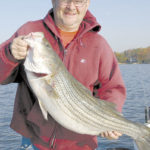
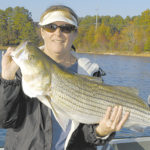
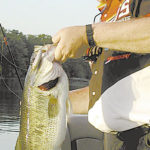
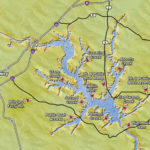



Be the first to comment